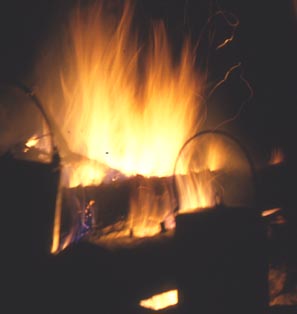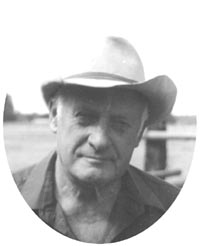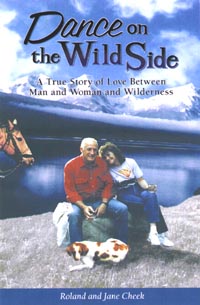a weblog sharing info on outdoor skills and campfire musing by a guy who spends a bunch of time in pursuit of both
CULTURE
WHERE -
TALES ARE TOLD OF
Welcome to Roland Cheek's Weblog
Roland is a gifted writer with a knack for clarifying reality. Looking forward to more of his wisdom
- Carl Hanner e-mail
The famous Western artist Charles Manion Russell must have been having a bad day when, in a talk given to the Great Falls Booster Club in 1923, he said:
To access Roland's weblog and column archives
Tip o' the Day
Think opportunity -- that's my Tip O' the Day.
Jane and I have become accomplished opportunists during our latter years. That talent manifested itself after years of being somewhat circumscribed by the circles our horses could make over wilderness trails. Then, after a little over two decades guiding others to adventure, we retired with the professed desire to guide ourselves to the same end.
Unfortunately a life filled in the pursuit of fun had yielded little in the form of filthy lucre, so we were compelled to venture out into the great beyond with a van loaded with our books to sell. Jane, as a peddler, is good at her trade. She allows me to be her chauffeur during these latest of our circles. It was opportunism that permitted us to blink at a Nebraska map, note that we had a weekend free, and see Rock Creek State Park was but a few miles away.
As it turned out, Rock Creek State Park is situated on 300 acres of tallgrass prairie, with several miles of hiking trails winding through it. A Pony Express way station, complete with the old log barn and replica corrals was there. And, as if that weren't enough, the Oregon Trail crossed Rock Creek right there on Park grounds.
There was a nice campground at the Rock Creek Park, with each site isolated from others amid rolling hills and juniper trees. Showers and restrooms were there, as well as macadam parking pads, electricity, and water at each site.
Parking pads? Electricity? Piped in water? Showers? Rest rooms? Is this the same folks who wrote the book Dance On the Wild Side, about their life of adventure in one of America's greatest wilderness?
I'm not sure if Ethan Lester, the 13-year-old Camarillo, California lad who likes my Westerns, has read any of my outdoor books. But Ethan isn't the only young person reading these days. Alexa Mrgich, a sixth-grader in Kalispell, Montana, wrote to say she's reading my book about elk [The Phantom Ghost of Harriet Lou}.
Alexa says, "I am probably the only girl you know that loves loves loves hunting." She says, "I go almost everday of hunting season, except for the week days." Alexa said her favorite story in my book is "where the 12-year-old boy and his grandfather go hunting".
If you find it bewildering that a young lass just entering her teens found The Phantom Ghost of Harriet Lou fine reading, consider that an officer on a U.S. Navy ship at sea liked it, too.
"I have just finished The Phantom Ghost of Harriet Lou. Wow! It was wonderful! I was transported from my stateroom aboard a destroyer to the wilderness I roamed as a teenager. Your tales were well told, enlightening, and dead on the money. The open ocean on a calm, clear night is beautiful, but I'll never hear the hoarse bellow of a rutting bull elk. Driving a warship into heavy seas and tailing green water on the bridge is exhulting, but not nearly as much as bucking into a northern blizzard and stumbling across grizzly tracks that haven't even begun to fill in [with snow]. Thank you for sharing with me. My dad has sent me the Thursday Great Falls Tribune no matter where I am in the world for the past 13 years. I have always enjoyed your columns, but this book was special.
Joel Stewart / USS Fife Dd 991
MOST DANGEROUS BEASTS
One might conclude, after reading stuff I've written about Treasure State beasts, that I'm not easily intimidated by wild creatures of any kind. Not so. A healthy respect for all animals, wild or tamed, is not only prudent policy, but necessary in application for virtually every outdoors adventure. After all, Montana crawls with creatures that can make any outing unpleasant, not the least of which are those who grow angry at your approach--like honeybees, bumblebees, yellowjackets, hornets, and wasps.
You're dismayed that I'm bringing insects into a discussion about Montana's most dangerous beasts? Perhaps, then, you should bear in mind that, despite dozens of encounters with grizzly bears on Lewis and Clark's journey across North America in 1804, mosquitos took a far larger blood toll from the intrepid explorers than did the most formidable carnivore in all the New World.
On occasion, yellowjackets made a few of our Bob Marshall Wilderness adventures particularly perilous. Hot, dry years seemed worst for yellowjackets. So it was in the Oregon of my youth, too, when I worked as a logger in the big woods. I'm not sure why, but moist, cool years seemed to hold the ornery yellow-and-black-striped boogers down.
Yellowjackets build their nests in holes--sometimes in tree cavities or logs, but most often in the ground, taking over holes of field mice. Shake the log or tree, or vibrate the nearby ground and they'll swarm out looking for an enemy with which to grapple. Makes no difference be it horses, humans, grizzly, or grouse, the insects only line of defense is to attack. In swarms. Stingers first.
It's my observation that it's always the third or fourth horse in line to get stung--then every horse thereafter. The principle probably has something to do with necessary lead time from hive detection to hive launch. The first horse rattle the ground; by the second passage, airborne wings are marshalled; the third sees them launched. From there on out it's Katy-bar-the-door! Pity those later horses and riders.
Naturally, if its a string of packhorses involved, the packer has no idea why his packstring suddenly comes unglued. Far as the lead horse and human is concerned the string is plodding peacefully along. The rider may even be dozing in the saddle. Then horses in the middle of the string starts bucking and dancing and heading for Waterloo. By the time he sorts out what's going on, yellowjacket dive bombers are descending on his saddlehorse and he, too, heads for neon lights at a crow-hop gallop.
A string of saddlehorses are just as susceptible as packhorses. Suddenly the third rider back--maybe that cute computer programmer from Minneapolis--starts screaming as her pony does the two-step through doghair lodgepole. Other riders are shouting and slapping at divebombing insects and the prudent guide is the one who order everyone (needlessly I might add) to get out of Dodge!
The tough part is when you're leading a group along a steep sidehill trail and discover you're in a battle with a beehive and finding escape uphill or down is not viable options. With the trail blocked both front and back with other horses and riders, what does one do? Our response was to develop a procedure where the first rider whose horse is stung shouts "BEES!" and everyone was supposed to jam heels to ponies in a dash past the hive.
The problem was we quickly learned that "BEES!" sounded a lot like "SEE!" and most riders would "Whoa" their pony in order to view their surroundings. The lag time between "whoa" and "help" was usually but a moment, but the lapse was crucial to a graceful exit versus a wild melee.
So we decided to yell "Yellowjackets!" But by the time all those syllables were spit out in amid ever-rising octaves most of the attacking waves were targeted on every warm blooded, stomping, slapping mammal on that mountainside.
Finally we decided on "HORNETS!" When that dread two-syllable word sounded, everyone was instructed to gallop up trail to safety. Key, of course, to that escape was that the lead rider must jump first in order to clear the way for others.
That meant me. The trouble was that my hearing had been dulled by age so much that "HORNETS!" coming out of a computer programmer wasn't always clearly discernible at two octaves over high soprano.
Roland Cheek wrote a syndicated outdoors column (Wild Trails and Tall Tales) for 21 years. The column was carried in 17 daily and weekly newspapers in two states. In addition, he scripted and broadcast a daily radio show (Trails to Outdoor Adventure) that aired on 75 stations from the Atlantic seaboard to the Pacific Ocean. He's also written upwards of 200 magazine articles and 12 fiction and nonfiction books. For more on Roland, visit:
www.rolandcheek.com
Recent Weblogs
Tuesday, July 22, 2008
for more info about these and other Roland Cheek books
There's a bunch of specific info about Roland's books, columns, and archives. By clicking on the button to the left, one can see Roland's synopsis of each book, read reviews, and even access the first chapter of each of his titles. With Roland's books, there's no reason to buy a "pig in a poke."
for detailed info about each of Roland's books
Read Reviews
Read their first chapters
For interested educators, this weblog is especially applicable for use in history, economic, and ag classes, as well as for journalism students.
Roland, of course, visits schools. For more information on his program alternatives, go to:
In my book a pioneer was a man who turned all the grass upside down, strung bob-wire over the dust that was left, poisoned the water and cut down the trees, killed the Indian who owned the land, and called it progress. If I had my way, the land here would be like God made it, and none of you sons of bitches would be here at all.
In all my experience in the wilderness wild, I find two of God's creatures especially fascinating: the ones you've read about above: elk and grizzly bears. Perhaps grizzlies are twice as fascinating because I've written two books about them, and only one for elk.
Learning To Talk Bear is Roland's best selling book, in its 5th printing. The book depicts his own learning curve to understanding the great beasts
An entire book devoted to a single charismatic grizzly bear
to send this weblog to a friend
to tell Roland what you think of his Campfire Culture weblog
to visit Roland's newspaper columns and weblog archives
source links for additional info
NEXT WEEK:
HOT WEATHER HEATHENS
www.campfireculture.com
Sure is. And these days Jane is loving every minute of it. These days, when we wake up and rain is pounding down on the roof of our little motor home, we eye each other, burrow a little deeper into our pillows, and murmur, "I don't have anything pressing to do today, do you?"
Opportunisim took us to visit Palo Duro Canyon, famed in Western history, in the Texas Panhandle. There we hiked their several miles of trails, hunkered down and watch Rio Grande turkeys while the gobblers gobbled, then flew from their nightime perches in live oak trees. We saw honest-to-God Texas longhorns, horned toads, road runners, and rattlesnakes.
Opportunity. Seize it!







